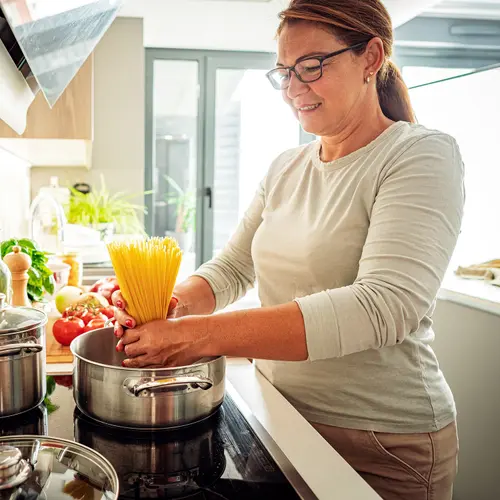Getting one well-balanced meal on the table every day, let alone three, can be a challenge for anyone. It’s even harder with all the other tasks of caregiving, especially if your loved one has special diet needs or trouble even tasting the food you make.
But food is the body’s fuel, and part of its medicine, too. For an older adult with a long-term illness, good nutrition takes on even more importance. And healthy eating isn’t all about calorie counting and scouring food labels. Meals are also a time for connection, and good food is one of life’s basic pleasures -- at any age.
To make meals less hectic, it’s useful to know which diet needs to look out for and ideas on how to meet them.
What's in a Good Diet
Usually, you get the vitamins, minerals, and nutrients you need with a well-balanced diet, but many older adults don’t. Here are some areas that often fall short.
B vitamins. Keep a close eye on vitamins B6, B12, and folate, also called folic acid. You can often get all three in cereals with added vitamins. You also get:
- B6 in whole grains and organ meats, like liver
- B12 in lean meats and some fish
- Folate from dark greens, beans, and peas
Calcium and vitamin D. These are important for strong bones. Calcium is in dairy products, like milk and yogurt, and in dark, green, leafy vegetables, like broccoli and kale. You get vitamin D from being out in the sun. That can be harder for someone who’s unwell, so look for products with added vitamin D.
Fiber. Fiber is good for the heart, helps prevent diabetes, and keeps you regular to avoid constipation. Good sources include beans, whole grains, and veggies.
Healthy fats. Try to limit fat (especially saturated) and cholesterol, and totally avoid trans fats. They can lead to heart and blood pressure problems. Healthy fats include olive oil, avocados, nuts and nut butters, soy milk, and tofu.
Potassium. Not eating enough potassium can raise blood pressure. You get potassium in foods such as bananas, potatoes, and yogurt.
Tips to Make Nutrition Easier
Getting nutrition right doesn’t have to be complicated. Start with the tips below, and keep in mind your loved one’s special dietary needs -- doctor’s orders come first.
Aim for a balanced plate. Fill half the plate with veggies and fruits. Then, split the other half between whole grains and a lean protein, like chicken or beans.
Avoid the bad fats. Fats can be tricky -- do you know your saturated from your polyunsaturated? Here are a few simple rules to help:
- Avoid solid fats, like butter, and use olive oil instead.
- Go with poultry, lean meats, and seafood.
- Use low-fat or fat-free dairy products.
Change it up. Variety is the spice of life and the key to health. Try to switch things up with different fruits, veggies, and proteins at every meal, or at least on different days.
Check for color. When you see a plate bursting with bright colors and lots of veggies, you got it right.
Stick to the basics. Much of nutrition comes down to this: lots of fruits and veggies, lean meats, beans, whole grains, and a few servings of dairy. Add in poultry, eggs, and some nuts, and you’re good to go.
Tips for Common Challenges
Feeding a loved one with an illness comes with special challenges. Here are some tips to help.
Chewing and swallowing. Cut food into small pieces and serve softer foods, like mashed potatoes and cottage cheese. You might also need to puree meals. If swallowing is an issue, thicker liquids and a straw can make life easier. And make sure to serve water with meals.
Confusion or stress. If meals are stressful, simplify things, and allow for small pleasures:
- Keep the table clear and only put out utensils you need.
- Serve a sweet some days, unless you can’t for health reasons. Even some fruit can do the trick.
- Try to eat together or have company to make meals more social.
- When offering foods, give just two choices. And maybe use smaller plates to serve just one food at a time.
Dull taste buds and loss of appetite. Sense of taste gets weaker with age, and some medicines make it worse. That can affect your loved one’s desire to eat. To make meals more appealing, you can:
- Skip the salt, but add lemon juice, vinegar, herbs, and spices to kick up the flavor.
- Use brightly colored foods to make meals more appealing.
- Vary the tastes and textures.
You might also offer 5-6 small meals or snacks instead of three larger ones. And help your loved one get physical activity, if you can. A walk or even washing dishes can help boost appetite.
Mouth soreness. If a sore mouth makes eating difficult, try softer, creamier foods, such as baked sweet potatoes or pasta. Also, have a dentist check your loved one’s dentures or teeth.
Strength and coordination issues. If utensils are hard to use, try finger foods, like cheese cubes or cut-up sandwiches.
Don’t Forget About Water
The sense of thirst also gets weaker with age. Many older adults don’t realize they’re thirsty until they’re already dehydrated. It can help to:
- Avoid drinks with added sugars.
- Put out water to sip throughout the day.
- Serve water; fat-free or low-fat milk; or low-sodium, clear broth.


